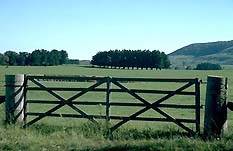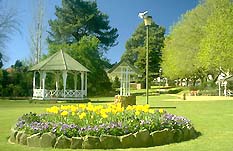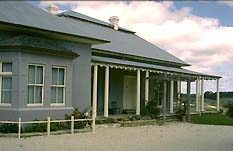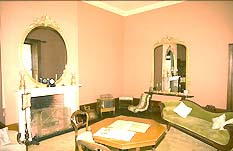
|
| The countryside around
Moss Vale |
Moss Vale
Major centre in the Southern Highlands
Moss Vale is located 124 km south-west of Sydney via the F5
Freeway and 672 m above sea-level. It is a quiet country
town of 5690 people (1991 figures) which functions as a
service and administrative centre of Wingecarribee Shire.
Like many Southern Highlands towns the climate and the
planting of European trees combine to create an English
village feel.
The area was once occupied by the Dharawal Aborigines,
though they had, in effect, been driven off or killed off by
the 1870s. The first European party to investigate the
district was that of ex-convict John Wilson in 1798. They
had been sent by Governor Hunter with the object of
accumulating factual data about the southlands to discourage
convicts who were escaping and heading south in the belief
that China was but 150 miles away. Wilson had been living
with the Aborigines for some years and had almost certainly
been in the area prior to the expedition. His party were the
first Europeans to sight the koala and lyrebird (at
present-day Bargo).
Over the next decade there were minor forays into the
district by the likes of John Warby and a botanical
collector for Joseph Banks named George Caley. The Hume
brothers, probably in the company of their uncle John
Kennedy, investigated the area in 1814. With pasturage
around Sydney becoming scarce John Oxley and his stockmen
drove some cattle into the area the following year.
In 1817 Charles Throsby, Hamilton Hume, Joseph Wild and
others explored the country west of Sutton Forest. They
returned in 1818 with surveyor-general James Meehan en route
to Jervis Bay passing through the eastern portion of what is
now Moss Vale. The following year Throsby and Wild were back
again en route to Bathurst. Governor Macquarie awarded
Throsby 1000 acres for his efforts and made him
superintendent over the construction of a road from Picton
to the Goulburn Plains. Macquarie visited the construction
site and Throsby's land grant at Bong Bong, just north of
present-day Moss Vale, in 1820. It was the governor who
suggested the name 'Throsby Park'.
A site for the establishment of a village to be called
Bong Bong was surveyed in 1821. It became the first European
settlement on the Southern Highlands but was never
proclaimed, perhaps because the flow of the Wingecarribee
was uncertain at the townsite and building material was
scarce. Throsby's servant Joseph Wild, who also contributed
greatly to the exploration of the area, received 100 acres
adjacent Throsby's. His hut was located adjacent the
Wingecarribee River near where the Bong Bong Bridge now
stands. A police building and huts for the accommodation of
a military detachment were also amongst the first buildings,
though the most popular was the Argyle Inn.
However, Bong Bong was short-lived. It was surveyed in
1821 but the road to Bong Bong was unpopular as it entailed
crossing the Mittagong Range and travellers preferred the
route via Berrima to the west. Hence the village did not
prosper. In 1837, as a sign of its demise, the post office
was moved to Berrima. All that remains today is Christ
Church, consecrated in 1845 after the village had ceased to
exist.
A visitor to the future site of Moss Vale in 1853
observed that there were five slab and bark structures and
wheat being grown. The subdivision of land around the
position of the prospective railway station began in 1864.
At the time the only inhabitant in the immediate vicinity
was Jeremy ('Jemmy') Moss, who was one of Charles Throsby's
herdsmen. It was from him that the town's name derives.
In anticipation of the railway line the Moss Vale Hotel
was erected in 1864 or 1865. Instead of following the route
of the main road to Berrima the line terminated where Moss
Vale now stands. When the station was built it was called
Sutton Forest while the post office, also established in
1867, was called Moss Vale. The nascent township's first
store also opened that year, the first school in 1869, the
first bank branch and newspaper in 1874 and a police station
in 1877.
The population increased from 134 to 570 between 1871 and
1881. The village prospered in the late 1870s and 1880s for
a number of reasons: it lay on the road to Robertson, it
grew as the main service centre for the dairying, market
gardening, and sheep and cattle raising district, a railway
line to Port Kembla was laid for the transportation of the
area's stores of limestone, and, like other Southern
Highlands town, it became a popular holiday resort when the
trains enabled wealthy Sydneysiders to discover the
beautiful scenery and healthy climate. This trend was
encouraged when Mrs Throsby removed to the original cottage
of Throsby Park and leased the main homestead to the
Governor of NSW, the Earl of Belmore, thus advertising the
desirability of the location for tourists.
The years from 1880 to 1888 saw churches built by the
main denominations - Presbyterian (1880), Anglican (1881),
Methodist and Catholic (both 1888) - while the present post
office building was erected 1890-91. Moss Vale was declared
a municipality in 1888.
Things to see:
![[Top of page]](smlArrow.gif)
Moss Vale Visitors Centre and Historic Walk
The visitors' centre has leaflets outlining an historic
walk.

|
| Leighton Gardens in the
centre of Moss Vale |
A Walk around Moss Vale
Leighton Gardens in Argyle St (the main thoroughfare) is a
pleasant spot for a picnic. There is a band rotunda. In
spring and autumn the trees in the park are spectacular.
Further up Argyle St, on the western side of the road, is
the old Dominican convent - an impressive building with a
row of elm trees leading to the front portal which looks
like it has been lifted out of rural France and placed in
the middle of Moss Vale. It is now Aurora College. In recent
years the convent has changed function a number of times.
Just past the convent turn right into Waite St (Berrima
Rd) and on the first corner (Browley St) is the Anglican
Church, built in the 1880s but much altered. Turn left into
Browley St and the Presbyterian Church is to the right
(1879). Also in Browley St is 'Kalourgan', thought to have
been the residence of Mother Mary McKillop (Australia's
first official saint) for a short time. The Catholic Church
is in Garrett St (head north off the main street into Lackey
Rd and take the first left).
The Southern Highlands Regional Gallery can be found in
Railway House, Argyle St. It is open from Fridays to Sundays
from 10-4. There are two antique shops on Argyle St - Clock
Tower Antiques at 249 Argyle St in the old post office
building - and the Argyle Street Galleries at 582 Argyle St.
The antiquarian bookshop, The Book Gallery, is at 551 Argyle
St.

|
| Throsby Park
|
Throsby Park
The most impressive residence from this time is Throsby
Park, now administered by the New South Wales National Parks
and Wildlife Service. It is an impressive colonial Georgian
residence set on land granted to Dr Charles Throsby in 1819
in recognition of his pioneering work exploring and opening
up the South Coast and Southern Highlands.
Throsby built a cottage on the land in 1823 for his
nephew as he preferred to remain at his home in Glenfield
and had no children of his own. The nephew, another Charles,
and his wife Elizabeth built Throsby Park in 1834. Elizabeth
was one of only four people not killed during a Maori attack
on a cargo vessel in New Zealand in 1809 when she was two.
The survivors were rescued by Alexander Berry, a friend of
her father. She was only 16 when she married Charles. She
bore him 17 children and lived to be 83. Her great-great
granddaughter still lives in the rear section of the
residence and runs Throsby Park Riding School, which
operates from the stables (c.1836), contact (02) 4868 1017.

|
| The main lounge room at
Throsby Park |
Throsby Park is largely unchanged and retains much of the
original furniture, cedar joinery and fittings. It is a
huge, one-storey, 27-room house built of locally-quarried
stone. Wings extend from the main block to form a courtyard
enclosed by a separate kitchen. There are cellars, servants'
attics, six-panelled cedar doors, marble and stone
fireplaces as well as a grand drawing room and dining room.
The 1823 cottage is also still standing and there are farm
buildings, including the sandstock-brick barn (c.1828),
which was formerly used as a shearing shed and is now a
private residence. Guided tours for groups can be organised
by ringing (02) 4887 7270 or (02) 4868 2721. The general
public's only chance to see the homestead and grounds is
during open days in Tulip Time (September-October). Ring
(1800) 656 176 for more exact details.
To get there head east of Argyle St along the Illawarra
Highway for 1.5 km and turn left into Throsby Park Rd.
Tudor House Preparatory School
Further down the Illawarra Highway, to the left, is the
famous Tudor House preparatory school, the primary school
for boys who usually continue their studies at The Kings
School at Parramatta. Among the schoolıs most famous old
boys was the novelist, and Nobel Prize winner, Patrick
White, who wrote of the school in his autobiography, Flaws
in the Glass: 'The school to which they sent me was far
enough from Sydney to foment terror in the heart of a timid,
introspective child, anyway in the beginning. It was
patronised by the grazier class and Sydney families with
social pretensions. The climate was bracing. The boys, like
those of any school, were said to love everything about it.
The building was a mansion in the Thames Valley Tudor style
favoured by the Australian rich in the early part of the
century.'
Other Attractions in the Area
Moss Vale Golf Club is in Arthur St, contact (02) 4869 2091.
They also have a lovely guest house for holidaymakers known
as The Dormie House, contact (02) 4868 1014.
Just north of Moss Vale is the site of the first European
settlement in the Southern Highlands, Bong Bong. To the
right, before Bong Bong Bridge is Christ Church, consecrated
in 1845 after the village had ceased to exist. It survived
because it was supported by people in the district and is
still used today. The cemetery is historic and contains
descendants of Throsby's nephew, as well as the tomb of
Joseph Wild.
Cross the Bong Bong Bridge over the Wingecarribee River.
On the right, behind a white gate in the pine trees, is a
cairn which marks the site where the first settlement on the
Southern Highlands stood.
Just past the cairn is a branch road to the right which
leads to Cecil Hoskins Nature Reserve on the banks of Bong
Bong Reservoir. This wetlands site has several walking
tracks, as well as picnic and toilet facilities. There are
plenty of waterfowl, as well as water rats and the
occasional platypus. Kangaroos and wallabies can be seen on
the eastern side of the reserve which was named after a
prominent scion of the Hoskins family, principal figures in
the foundation of Australia's iron-and-steel industry. Cecil
Hoskins, one-time chairman and joint managing director of
AIS, formerly lived at Moss Vale. There are leaflets
concerning the animal life in the area available from the
Fitzroy Falls Visitors' Centre, contact (02) 4887 7270.
Further north on Moss Vale Rd, to the left, just north of
the Bowral Flight Centre, is historic Briars Inn, originally
the Royal Oak Hotel, built c.1845. This two-storey brick
building was owned by the Throsby family until 1943 and was
then renovated. One of Charles Throsby's children lived
there until 1891.
A short distance south of Moss Vale, Oldbury Rd heads
north off the Illawarra Highway. Therein lies Oldbury
homestead, a two-storey stone Georgian house built in 1828
by James Atkinson on land he was granted in 1818. It has a
timber Doric portico and cantilevered timber stairway with a
separate kitchen and cellar.
Another way to see the surrounding countryside is to take
a ride on The Cockatoo Run, a leisurely train trip on
olden-style carriages (pulled by steam train except in
exceptional circumstances) to Robertson or down to the
lllawarra. It operates from Saturday to Tuesdays and on
public holidays, contact (1800) 64 3801.
The Wangaruka Berry Farm, on Nowra Rd, has fresh berries,
jams, pies and home-made ice-cream in season (December to
April), contact (02) 4887 7278.
The Moss Vale Agricultural Show is held in March. The
largest markets of the Southern Highlands are held on the
fourth Sunday of each month at the Moss Vale showgrounds on
the Illawarra Highway.

Broadwalk
Business Brokers
Broadwalk Business
Brokers specialise in General Businesses for Sale, Caravan Parks for
Sale, Motels for Sale, Management Rights & Resorts for Sale, Farms for
Sale, Hotels for sale,Commercial & Industrial Properties for Sale.
Phone:
1300 136 559
Email:
enquiries@broadwalkbusinessbrokers.com.au
AUSTRALIAN BUSINESSES FOR SALE
COFFS HARBOUR BUSINESS BROKERS
BROADWALK BUSINESS BROKERS
GOLD COAST BUSINESSES FOR SALE
BRISBANE BUSINESSES FOR SALE
SYDNEY BUSINESSES FOR SALE
CARAVAN PARKS FOR SALE
BUSINESSES FOR SALE
MOTELS
FOR SALE
HOTELS
FOR SALE
Disclaimer
We advise prospective purchasers that we take no
responsibility for the accuracy of any information in the business
provided by vendors or their professional advisers and that they should
make their own enquiries as to the accuracy of this information,
including obtaining independent legal and/or accounting advice
Moss Vale

